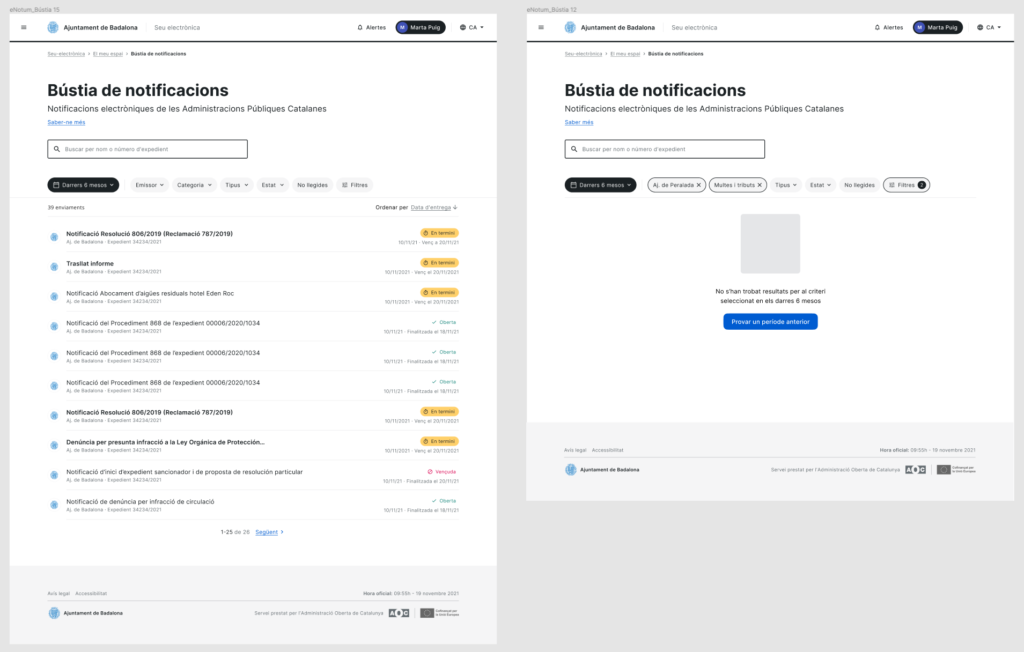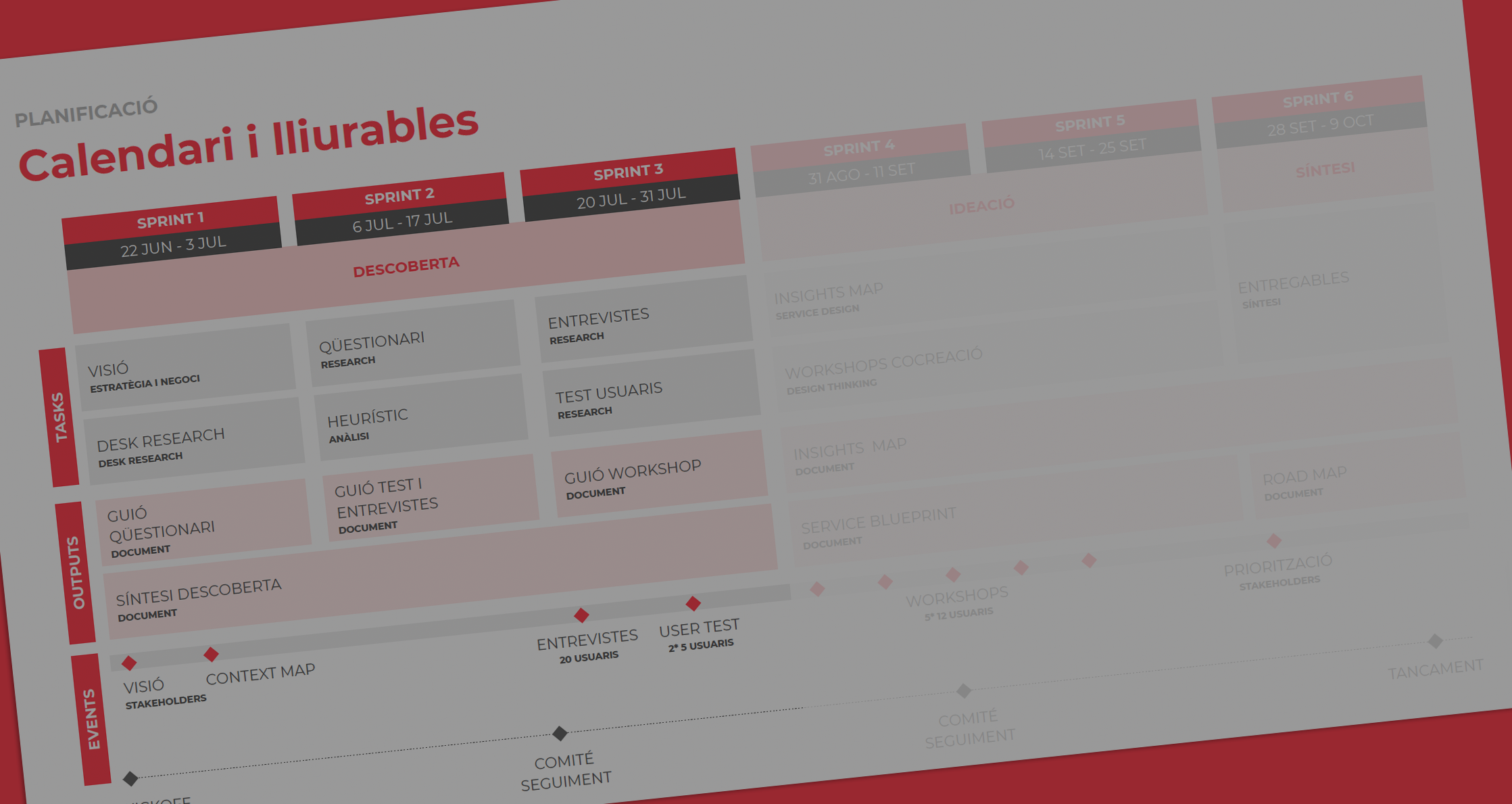Challenge
As we can create digital services that are easy to use and understandable for everyone and be a reference in the public sector?
Problematic
The AOC offers numerous services that reach both citizens and companies, as well as public administrations. We often find, however, that these have been created at different times, for different needs and with different priorities, which have often not allowed us to go deep enough into the real needs and problems of users.
This context, very common in organizations of this magnitude and with such a great diversity of services, has meant that, over time, bottlenecks appear that end up being transferred to the users, making their tasks more difficult and causing a bad experience with the administration In these interbanks are mixed:
- design: conceptualization and proposals not sufficiently focused on the people to whom the services are theoretically aimed. Creating solutions that are far removed from the mental model and real needs of users hinders the value and ease of use of services.
- Functionality: Inconsistencies in processes, making tasks difficult for users, whether citizens or public workers.
- Style: Visual and aesthetic inconsistency leading to the loss of identity of AOC services and the difficult adaptation by other public bodies.
- understanding: Sum of the lack of visual clarity and content, due to the use of a confusing and complex language accessible only to some groups.
- Accessibility: Solutions in which certain users are excluded whether or not they have any limitations.
Behind many of these problems there is not only a design challenge but also technological and legal challenges that make this transformation difficult and make decisions shared and sometimes not progress at the desired pace.
Proposed solution
Integrate into the design of the services, techniques, methodologies, and even an own mentality, which helps us to solve the problems and needs that users have when dealing with public administrations.
The main methodologies that we keep in mind during the design of an AOC service are:
- Design thinking, more than a methodology, a way of thinking to solve problems or innovate in services. It consists of different steps and we have made them our own in the redesign of any of the services:
- Discovery: Understand well the needs of the service and the user through tools such as: Strategic Vision, Surveys, Interviews, Desk Research, Shadowing, Mirroring, etc.
- Ideation: Create possible solutions through co-creation and prioritization techniques.
- design: From the creation of User Journeys per service, to semi-functional prototypes of the interface or the creation of the Design System (DS) of the AOC.
- Validation: Tests with users to validate hypotheses in a safe environment, with room for maneuver to be able to iterate.
- content strategy, a good user experience must be accompanied by care in language and communication. So, from the beginning we worked on the tone of voice we should use to address our users, and specifically for each service a writing guide and a glossary of terms to improve it the understanding The objective: Lighten the contents by simplifying the legal language, and think about behavioral design such as a good distribution of the content using the most suitable visual resources.
- Growth strategy, introducing data analysis as an internal culture, with the following objectives:
- Detect improvements in the use of services through dashboards by heads of service.
- Evolve the services by improving the conversion, so that they can make use of the largest possible number of users as a digital right that they have.
In all these methodologies, the involvement of citizens, public workers, heads of service, managers of different areas involved and developers.
We differentiate between 2 areas of application of these methodologies, administration staff and citizens.
Administration staff
From the side of the work of the public administration staff, a specific research project of the EACAT platform was started in 2019. One was made intensive work with public employees to detect the main drawbacks and needs, and to mark the roadmap for the next phase of design and development through prioritization techniques that involved the 3 axes:
- Users
- Technology
- Business
This second phase began in 2021 and it was here that it was deemed essential to create the Design System for the reformulation of EACAT, and at the same time mark the principles that would serve as a basis for the rest of the services.
What is a Design System?

A Design System, or Design System (DS) in English, it is a set of principles, standards, guidelines, components and tools which are used to consistently design and develop brand and digital products. These components they may include design elements such as icons, colors, typography, animations, and may also include guidelines for content writing, information structuring, and interface hierarchy.
The purpose of a DS is to provide a solid foundation for the design and development of digital products, ensuring they are consistent in terms of style, design and functionality. It also enables designers and developers to work more efficiently and effectively by providing a library of reusable components and consistent guidance for their implementation. A DS also helps ensure a consistent and cohesive user experience across all platforms and devices. At the AOC we have created 2 Design Systems, one for citizens and another for public workers.
From here and up to today, work has been done on the new EACAT, as a joint project between Business, Design and Technology, putting the user always at the center to delve into the solutions and validate their progress, until reaching one EACAT validated prototype. This progress is slow and difficult to make tangible for the user in the short term, since to reach a minimum viable product (MVP) many technological challenges must also be faced.
In the same way that the visual and functional design has been treated, too language and tone of voice have been worked on. At the beginning they were defined principles regarding communication style and subsequently generated one specific writing guide by EACAT and one glossary of terms who is still alive
As to Growth strategy, at the beginning of the project it was defined which it was the Indispensable Experience (MHX) and the key indicators to guarantee this, and to ensure that we do not deviate from it to provide value and achieve a good user experience.
Services for citizens and businesses
Concerning the side of citizenship and business, although in recent years efforts had been made to implement a design culture centered on the user, or better said, citizenship, with techniques and methodologies such as Design Thinking, Lean Start-up and their backpack of tools (interviews, co-creation workshops, ideation or guerilla tests, MVP, analytics...) it has not been possible to apply it in a systemic way until very recently.

In 2022, work has been done on the redesign of different services: Seu e-mail, idCAT, Decidim, Representa and eNotum, among others. In the same way as in EACAT, it was also reformulated Design system for all those services of the AOC that are offered to citizens and companies through different organizations. In the same way as in the case of EACAT, this aspect has also been worked on in parallel with the Design System, the tone of voice and aspects related to the language that must be used in the citizen relationship public administration.
In terms of analytics and data strategy, a user experience (UX) oriented dashboard for each service, focusing mainly on the following key indicators:
- % Service conversion, i.e. % success in completing the main task.
- Creation of funnels and time it takes the user to complete them.
- Identifying errors and where they start from.
At the foot of this entry we provide you with some deliverables from the eNotum service.
Why 2 Design Systems and not a single one?
Just as the tone of voice is not the same for a public worker as it is for a citizen/company, neither is the DS. Regarding the language, we always try as much as possible to bring the administration closer to the user using plain language or provide explanations in the form of help in those cases where it is not possible. It is true, however, that in the case of inter-administrative services we can consider public workers as "experts" and they need less clarification than other types of user due to their knowledge and regular use.
This differentiation can also be made at the design level, since the type of services and use made of inter-administrative services is very different from that of the citizen/company. EACAT responds to a more compact DS, focused on guaranteeing the usability and scalability of the public worker's work tools. The other DS, on the other hand, is more oriented towards simplifying communication with the citizen and facilitating their relationship with the administration, with an even cleaner and more spaced design, bearing in mind that we have a much more diverse audience and that the use is much more sporadic than that of the public worker. It should also be said that in this second DS more neutrality has been sought, without a marked identity and with a more chameleon style to facilitate integration in the different organizations.
Status of the project (exploring / under construction)
The new EACAT is in the design and development phase and is expected to be launched next year.
With regard to the services intended for citizens and companies, currently the majority, and especially those that integrate the electronic headquarters, have visual prototypes adapted to the new Design System, where their development is already included in the roadmap of each service . In addition, some of them, such as El Meu Espai and Representa, are undergoing profound changes that will help facilitate the relationship between citizens and the Administration.
We will inform you!
More information
- EACAT project documents
- Documents of the eNotum project
- Design Systems of the AOC
- Design systems in the public sector

